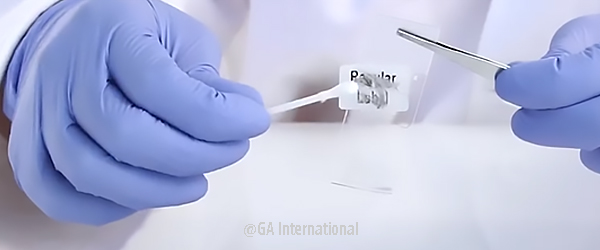
#1 – Water
Water is the single-most common substance you’ll encounter in the lab. As one of the best solvents in nature, it is used to prepare most solutions used in the lab, from media used to feed cells to buffers and reagents. While useful for solution preparation, this is a physical property that doesn’t do your labels any favors. Paper labels in particular are quite absorbent; as the labels absorb water (or almost any liquid), it renders them unusable. Water may also hinder your ability to stick labels to their containers, as most adhesives will not bind wet surfaces due to their hydrophobicity.
While paper labels are great for general use in the lab and for office work, labels made of a durable thermoplastic film are your best bet when you need something that will last when exposed to wet and damp conditions. For tubes, vials, and other surfaces that are already wet and need to be labeled or re-labeled, NitroTAG™ labels will affix no matter how wet the surface is.
#2 – Organic solvents
There are many organic solvents found in the lab, with some of the most common being:
- Xylene, an organic solvent primarily used in histology.
- Dimethyl sulfoxide (DMSO), an all-purpose lab solvent. It is also an efficient cryoprotectant, allowing cells to be frozen cryogenically without inducing the formation of damaging ice crystals.
- Acetone and formaldehyde, two organic compounds used in tissue fixation, preservation, and other biological techniques.
Unfortunately, all these organic compounds can cause ordinary labels to fail. The solvents will solubilize most commonly used adhesives, slowly degrading them during long-term exposure and reducing the cohesion between the molecules of the adhesive, thereby lessening the adhesion between the label and surface. Many types of ink are also soluble in organic solvents, fading or completely rubbing off after even short periods of contact.
There is only one solution to ensure your labels remain adherent even when exposed to harsh solvents: using a stronger adhesive specifically designed for chemical exposure. As for the printout, two solutions are available to prevent the ink from being smudged or removed by organic compounds: adding a protective laminate or varnish to your label and printing your labels using a thermal-transfer printer and a high-quality resin ribbon. The addition of either a laminate or a varnish on printed labels will protect your ink from smudging (varnish can also be applied to blank labels prior to printing). Laminating your labels, though representing a higher expense, offers the best protection against chemical exposure as well as scratching, abrasion, and other extreme conditions. Printing your labels via thermal-transfer with a resin ribbon can offer a similar level of resistance against xylene and most other organic compounds, but for a fraction of the cost.
One problem some may encounter when handling organic compounds is the effect they have on labels printed with a direct thermal printer. The leuco dye used in direct thermal labels, which turns black when heat is applied, may also turn entirely black when exposed to harsh chemicals, as the reaction between the label’s leuco dye and the exogenously added chemical will produce enough heat to change the label’s color.
#3 – Alcohols & bleach
There are many kinds of alcohols, but the ones most commonly used in the lab are ethanol, isopropanol, and methanol. Alcohols are indispensable for many common lab techniques, like DNA purification, western blot, and tissue fixation. Ethanol, at a concentration of 70% diluted in water, is also widely used to sterilize benches and biosafety cabinets, making it an integral part of performing cell culture. Although 70% ethanol solution is effective at killing bacteria, bleach (otherwise known as sodium hypochlorite) is also frequently applied to disinfect lab benches, equipment, and biosafety cabinets, removing any remaining contamination. Labels can therefore be continuously exposed to alcohols and bleach, both of which pose a risk to the top coat, adhesive, and printed ink of the label. Like organic compounds, alcohols and bleach can solubilize the adhesive and smudge or completely remove the ink that isn’t alcohol- or bleach-resistant.
Labels can be made to withstand alcohols and bleach with a similar set of conditions to those listed above for organic solvents (i.e. using a stronger adhesive, laminate, varnish, or thermal-transfer printing). Though using laminates and thermal-transfer printing are the two best methods for preventing the solubilization of your ink, alcohol-resistant markers can also be used on the face stock of hand-written labels. Note that, like organic compounds, alcohols and bleach may also cause direct thermal labels to blacken entirely.
#4 – Liquid nitrogen
Liquid nitrogen is widely employed to store samples, primary cells, and immortalized cell lines for extended periods of time. Unfortunately, the adhesive of your labels may weaken in temperatures as low as -196°C (-321°F), causing them to fall off your vials or tubes. This is a result of extreme cold lowering the amount of van der Wahls interactions occurring between the surface of the tube and the adhesive, reducing adhesion, and making it harder for the label stick.
Cryogenic labels are prepared specifically for storage in low temperatures and are compatible with any container that will be stored in liquid nitrogen. Their adhesive is made from materials with an elevated amount of available van der Wahls interactions, making the labels more adhesive and ensuring that they won’t come off after long-term immersion in liquid nitrogen Dewars.
Before labeling your tubes and vials, it’s always wise to consider the types of compounds your labels may be exposed to. Choosing the right label is essential to ensuring that they stay affixed and legible, which is critical when you need your experiments to run smoothly and error-free.
LabTAG by GA International is a leading manufacturer of high-performance specialty labels and a supplier of identification solutions used in research and medical labs as well as healthcare institutions.